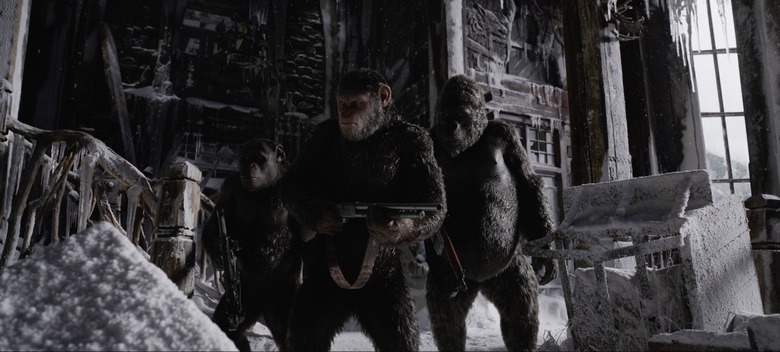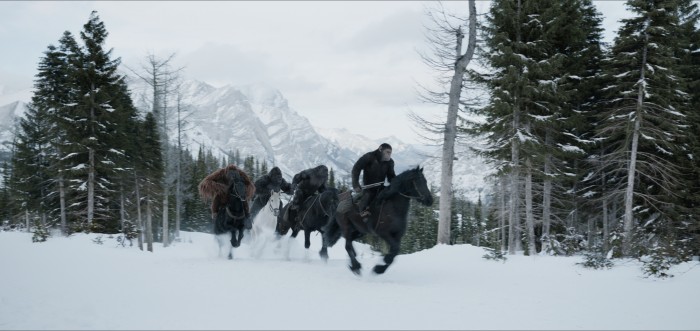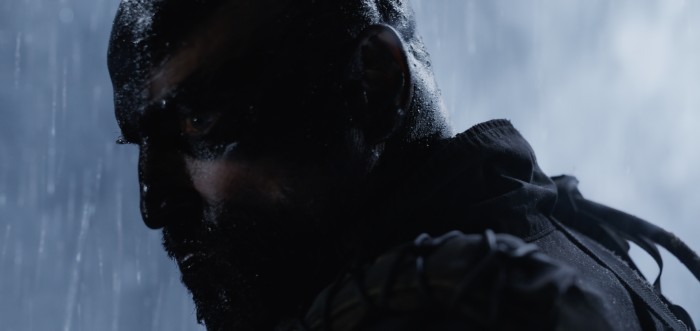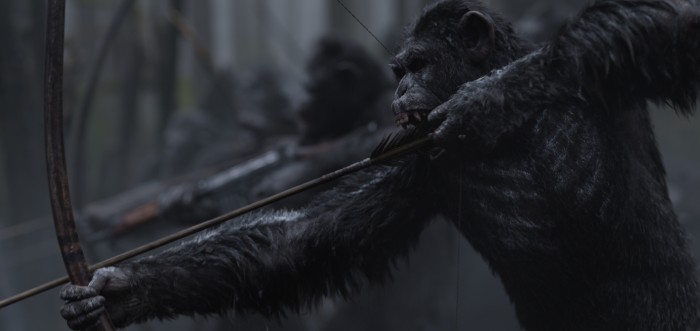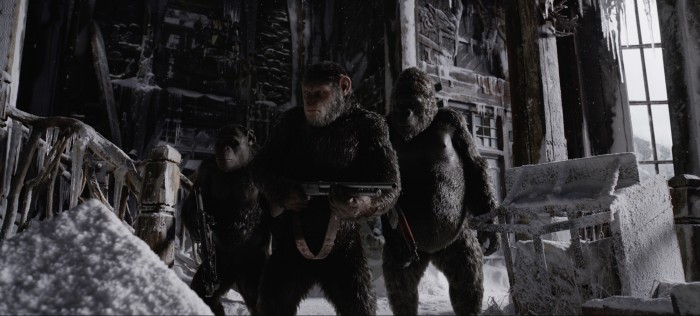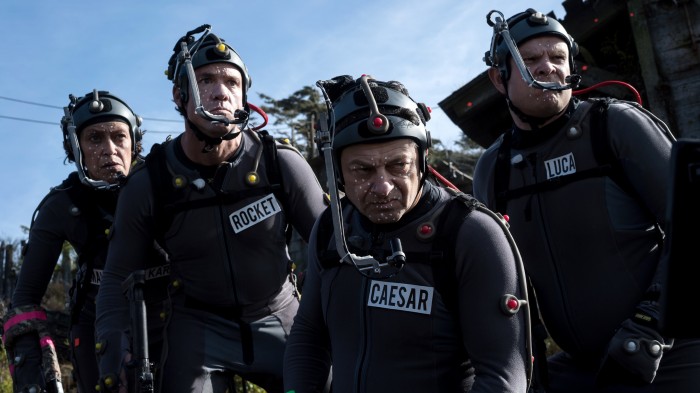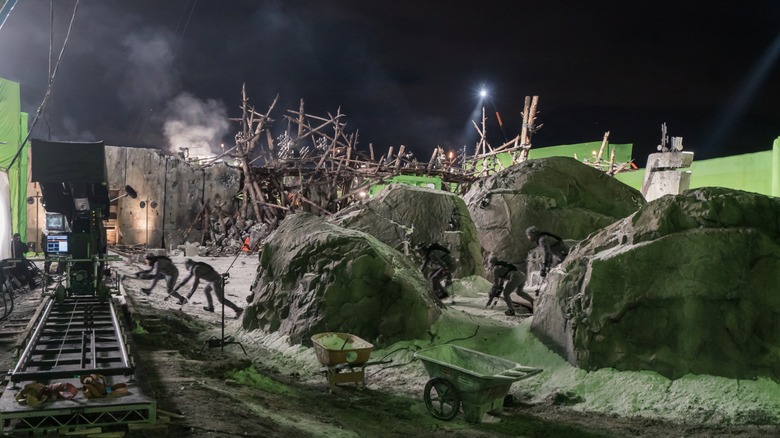Everything We Learned On The Set Of 'War For The Planet Of The Apes'
On January 13th, 2016, I traveled to Vancouver, British Columbia Canada to visit the set of Matt Reeves' War for the Planet of the Apes. After the jump you'll be able to read a round-up of everything I learned while on the War for the Planet of the Apes set visit. Elsewhere on this site you can read interviews with some of the producers and stars of the film.
The Story of War for the Planet of the Apes
War for the Planet of the Apes takes place two years after Dawn of the Planet of the Apes. Producer Dylan Clark believes this is the best opening for all of the ape films. The film begins with a serious military fight going on with the apes, resulting in the loss of many apes and humans.
The virus has found a rebirth, mutating and becoming more aggressive. The drug has evolved and has enabled Caesar to develop further. The apes learn that there are other apes outside of their tribe who are evolving and changing.
The film is not just about the war between the humans and the apes, but the conflict inside Caesar. The apes have found a promised land where they feel they can start over. Caesar decides he is no longer fit to lead the apes and goes on a dark journey to try to get revenge and find his humanity. War for the Planet of the Apes is more of a road trip story, and we're on a journey through the western part of the United States.
The Apes Will Be a Larger Focus of This Movie
This film is set two years after Dawn of the Planet of the Apes because the filmmakers didn't want to jump too far down the road as they wanted to see the next step in the evolution of the apes' culture.
This film features more apes and fewer humans than the previous two installments. The ape characters were in about 30% of Rise of the Planet of the Apes. In Dawn of the Planet of the Apes, that number went up to 60 or 70%. This movie, War for the Planet of the Apes, will have apes in 95% of the finished film. They wanted human characters to provide as much obstacle, character, and resistance for Caesar. We will get a global perspective of the state of the world, but the films have been very POV-driven, so we will only see the apes through this one community.
In this film, Caesar is physically more human-like. He speaks better English, and the English language is his primary form of expression. The film has a lot more sign language. The apes have not progressed to full dialogue — it's only been two years since we saw them last and the writers explored how much further these characters would have evolved in that time. The younger apes speak more but the older apes have evolved very little. The apes in War for the Planet of the Apes walk slightly more upright, in an evolution comparable to that change from Rise to Dawn.
An Epic Western Shot on 65mm Film
Producer Dylan Clark described the film as "a western and Caesar is Clint Eastwood." This is a darker and more brutal film, not in an overly graphic way, but in its emotions and context.
War for the Planet of the Apes is being shot in 65mm cameras. The film will be converted to 3D in postproduction because they have the time in post to do it this time around and the filmmakers wanted to shoot the movie on 65mm film. They are trying to create an epic western, which is partially why they decided to shoot on 65mm as it benefits the exterior shots, as they often go high and wide. The producers reference filmmakers like David Lean for the look they are trying to achieve.
Despite using a larger resolution film format, they will not be rendering the effects at a higher resolution. It takes about 30 hours per frame to render the apes at 2K resolution. If they wanted to render the effects in 4K it would have added another year to the post-production schedule.
The scope of this movie is so much bigger than the last film. There are more sets and bigger sets. Most of the film is being shot on exterior sets, probably close to 70 percent of the movie. Out of 80 shooting days, they are on stage for only fifteen days. All the sets are 3D scanned, and WETA has them if they need them to recreate or film new shots in post with the performance capture actors. There is only one digital set that is an interior/exterior ape location. The tower at the end of the last film was entirely created digitally.
Horses are a huge part of this movie, and there are classic western style shots with apes on horses that will be a huge challenge for this film. The apes' relationship with the horses is more "animal working with animal" than the typical human/horse relationship. They are hoping to include a moment between an ape and his horse that shows a deeper relationship.
New Characters: Steve Zahn's Ape and Woody Harrelson's The Colonel
Steve Zahn plays a chimpanzee, and he speaks "in a cool way." The character is going to take some steps forward visually. He has a unique look and he will add some levity to this dark world. Terry Notary calls Steve Zahn's character a "sprite of goodness." He will take the story in new directions and lighten up the story, which is needed.
The main human antagonist in the film is The Colonel played by Woody Harrelson. The apes become captured by The Colonel, and are being asked to do a task "that only apes can do." Harrelson's character has a strong point of view that is in direct opposition of Caesar's, but he's not a mustache-twirling villain. Woody's character wants to survive, and he believes that is at the cost of the apes. Woody's character knows who Caesar is and the humans have been after him for some time.
Old Friends, Not Forgotten
Don't expect Koba to come back in this movie. It was confirmed to us that the character died in the climactic events of Dawn. Matt Reeves and the producers loved Koba, and was sad to see him die in Dawn. They had conversations on how they could possibly bring him back and decided to add an audio cue at the end of Dawn just in case they wanted to. But in the end, they decided no one could survive that fall, thus he is not in this movie. That doesn't mean that his presence won't be felt in this movie. There were a lot of Koba sympathizers in the ape community at the end of Dawn of the Planet of the Apes. Some of the apes saw Caesar as weak and Koba as strong, and there is sure to be internal conflicts as the story progresses.
Jason Clarke and Keri Russell's characters will not appear in this new film. They might be acknowledged in some way, in the same sort of way James Franco's character was referenced in Dawn. They wanted to move on to a new drama that doesn't require bringing the human characters from the last film back.
Maurice is once again played by Karin Konoval, a 125-pound woman playing the huge 300-pound orangutan. Maurice's journey is richer, deeper and fuller. Psychologically we see him evolve. He will not leave Caesar's side, as he is Caesar's advisor, but that doesn't mean he isn't willing to challenge Caesar at times. Maurice is always assessing what the most effective thing to do in any situation, and staying away from violence until it's absolutely necessary.
The friendship between Caesar and Rocket has grown through the loss of his son in the last film. It's a bit of a role reversal. Rocket is now a confident, a general, but also someone who will get his hands dirty in the trenches.
They pay some homage to the mythology of the previous Apes films, but it's not a driving factor.
New Visual Effects Challenges and Technology
The big evolution with the technology of the performance capture suits is that now the batteries for the motion capture suits are housed in a removable backpack, instead of attached to various limbs and body parts. This allows the ape actors to not get caught in foliage or other set decorations. This also them to rest without the heavy batteries in between shots.
The ape characters have been completely rebuilt in the computer to improve with the technology.
Terry Notary is one of five ape actors who will paint all the many background apes in the performance capture volume after principal photography. They can only film with a maximum of nine apes on set at once due to the limitations of the performance capture technology.
The visual effects team referenced other animals that live in the snow, like elk, to inspire the look of the environmental effects on the apes in this film. WETA has a great relationship with the Wellington Zoo and the visual effects team visit the zoo often for reference for the films. There has never been a live ape on set of this or any of the previous Planet of the Apes films in this series.
Performance capture is being done on location in snowy settings for the first time in this film. Shooting in snowy locations presents a huge challenge because the human actors on Ape stilts walk differently from take to take, creating completely different footpaths in the snow. The result is that the entire path in the snow will have to be digitally recreated in post. In the last movie the big challenge was wet fur, and in this movie a big challenge is making snow and ice look real on the apes' fur. The apes don't wear clothes yet in this installment but that will be a big challenge for a future films.
They've added balls to the bottom of the arm stilts which makes it much easier for the ape actors to move around. The process of walking around on the arm stilts is still very cardio-intensive. Konoval went to the gym two hours a day in the months leading up to filming to prepare for the physical exertion. The arm stilts easily break, bend, or have various other problems. Which is whyNotary redesigned the arm stilts in carbon fiber. He plans on marketing them to the public at some point as an exercise device. He describes using the stilts as "like swimming on land."
The Future of the Apes Films
This movie is a much more complete story and producer Dylan Clark believes it has a better ending than Dawn of the Planet of the Apes. He believes that this ending could be good enough to be the end of the franchise if needed. That said, he would like to make more Apes films and believes there is more story to be told. The movie will not end with the planet ruled by apes, which means there is still room to tell more story between War and the original Planet of the Apes.
The filmmakers have created elaborate backstories for all of the ape characters that could theoretically be made into a prequel someday. For instance, Maurice grew up in a circus which is where he learned sign language. There is a story that has been created for this backstory that is very fleshed out.
What We Saw On Set
To give you some perspective of exactly how long ago I was on set, it was just days after David Bowie died and a couple weeks after Star Wars: The Force Awakens broke Avatar's domestic box office record. We visited on day 54 of 96 days of production. War was being shot in Vancouver, British Columbia Canada, where all three of the new Planet of the Apes films have shot at least partially. (I visited Dawn in Louisiana, where they constructed the exterior downtown San Francisco sets.) This is the first film franchise for which I've actually visited the sets of three sequential installments. The set was constructed in a former overflow car lot in Richmond, and the day we were on set it was cold and rainy so they were shooting a condensed day.
The set we visited was an armory which became a quarantine compound during the days of the simian flu. In this film, the armory up in the Sierra Mountains has been turned into a military base for human soldiers. The working title for the production was "The Hidden Fortress," which was printed on the clapboard and the call sheets. The hidden fortress is through the tunnels behind a waterfall (a location which will be completely created in CG).
They have captured apes and had them rebuild architecture, a wooden gate at the front. A concrete structure, surrounded by mountains, dusted with a little snow. In a scale model of the set, we saw two outdoor prison yards filled with apes, basically an ape internment camp. The set was constructed in the middle of a parking lot with shipping containers and huge cranes holding up massive pieces of green screen which will be augmented with visual effects to fill out the surrounding area. The scene we saw shooting was Gabriel Chavarria talking to Caesar about how Woody Harrelson's character respects him, Caesar appears to be hanging on a cross.
Signs spotted on the set included: "The future influences the present as much as the past," "Their blood, your sacrifice," "He who has the why to live can bear any how," "We are the alpha omega." We saw another shot where a bunch of apes, shackled together, are led through the prison yard toward the front. Apes which appear to be on the side with the humans hold guns out at their ape brothers, alongside the human military characters. Pan over to some guards who hear something and fire a gun towards the camera, we pan over to a rocky cliff above.

